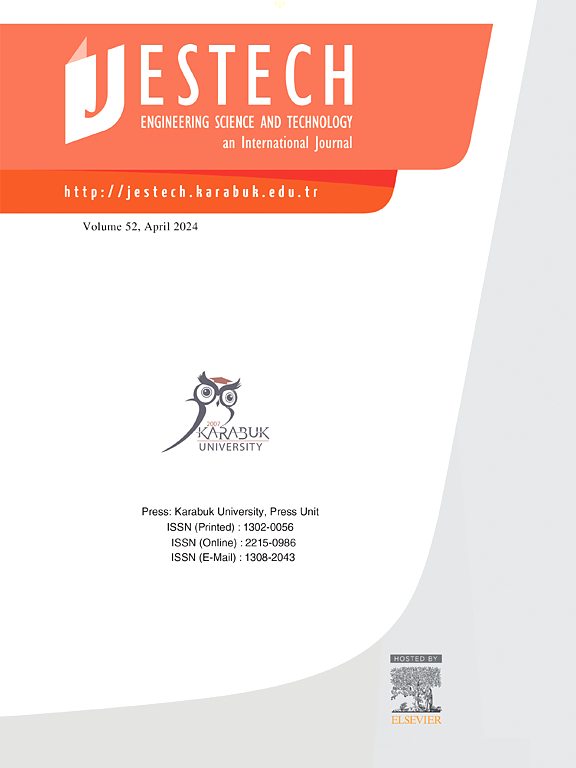虚拟现实应用中6ghz以下5G MIMO天线槽型的群智能驱动逆设计
IF 5.1
2区 工程技术
Q1 ENGINEERING, MULTIDISCIPLINARY
Engineering Science and Technology-An International Journal-Jestech
Pub Date : 2025-03-08
DOI:10.1016/j.jestch.2025.102026
引用次数: 0
摘要
本文提出了一种开发具有增强带宽和高隔离度的小型sub-6 GHz 5G MIMO天线的有效方法。利用粒子群优化(PSO)在像素化表面上的能力,制定了一个目标函数,以最小化带宽的倒数,同时确保反射系数(|S11|)保持在-10 dB以下,透射系数(|S21|)保持在-20 dB以下。这种方法有效地消除了合并复杂解耦网络以增强隔离的必要性。逆设计概念在2元MIMO天线的两种不同配置的槽布置中独立实现:其中一种是将单个天线组件置于反平行方向,另一种是将其正交布置。优化后的设计尺寸为24 × 48 (0.4λo ×0.8λo) mm2,在正交场景下的工作频谱范围为4.53 GHz至7.01 GHz,在自由空间的反平行方向上的工作频谱范围为3.95 GHz至5.15 GHz。在工作带宽中观察到的ECC <;0.0173和MEG <;-6 dB支持令人满意的MIMO天线分集性能。由于端口之间的电流耦合可以忽略不计,这些MIMO天线的分集增益接近10 dB,非常适合集成到虚拟现实(VR)耳机中。原位路径损耗测量活动通过将天线集成到参与者的虚拟现实耳机中来执行。所提出的MIMO天线的性能已经通过数值分析、等效电路建模和使用制造原型的测量活动进行了测试。测试原型的实验结果与模拟结果密切一致,证实了所提出的设计在自由空间和接近人体时的有效性。本文章由计算机程序翻译,如有差异,请以英文原文为准。
Swarm intelligence driven inverse design of slot patterns for sub-6 GHz 5G MIMO antennas in virtual reality applications
This paper presents an efficient approach for developing miniature sub-6 GHz 5G MIMO antennas with enhanced bandwidth and high isolation. Utilizing the capabilities of particle swarm optimization (PSO) on a pixelated surface, an objective function is formulated to minimize the reciprocal of the bandwidth while ensuring that the reflection coefficient () remains below -10 dB and the transmission coefficient () is below -20 dB. This methodology effectively eliminates the necessity for incorporating complex decoupling networks to enhance isolation. The inverse design concept is independently implemented in the slot arrangements of two different configurations of 2-element MIMO antennas: one in which the individual antenna components are placed in an antiparallel orientation, and the other in which they are arranged orthogonally. The optimized designs, measuring 24 × 48 (0.4 ) in size, yield operating spectra spanning from 4.53 GHz to 7.01 GHz for the orthogonal scenario and 3.95 GHz to 5.15 GHz for the antiparallel orientation in free space. An ECC 0.0173 and MEG -6 dB, observed in the operating bandwidth, supports satisfactory MIMO antenna diversity performance. Having negligible current coupling between ports, these MIMO antennas, with a diversity gain of close to 10 dB are well-suited for integration into virtual reality (VR) headsets. In situ path loss measurement campaign was executed by integrating the antenna into participants’ virtual reality headsets. The performance of the proposed MIMO antenna has been tested through numerical analysis, equivalent circuit modeling, and measurement campaigns using fabricated prototypes. Experimental results from testing the prototypes closely align with the simulations, confirming the effectiveness of the proposed designs both in free space and in proximity to the human body.
求助全文
通过发布文献求助,成功后即可免费获取论文全文。
去求助
来源期刊

Engineering Science and Technology-An International Journal-Jestech
Materials Science-Electronic, Optical and Magnetic Materials
CiteScore
11.20
自引率
3.50%
发文量
153
审稿时长
22 days
期刊介绍:
Engineering Science and Technology, an International Journal (JESTECH) (formerly Technology), a peer-reviewed quarterly engineering journal, publishes both theoretical and experimental high quality papers of permanent interest, not previously published in journals, in the field of engineering and applied science which aims to promote the theory and practice of technology and engineering. In addition to peer-reviewed original research papers, the Editorial Board welcomes original research reports, state-of-the-art reviews and communications in the broadly defined field of engineering science and technology.
The scope of JESTECH includes a wide spectrum of subjects including:
-Electrical/Electronics and Computer Engineering (Biomedical Engineering and Instrumentation; Coding, Cryptography, and Information Protection; Communications, Networks, Mobile Computing and Distributed Systems; Compilers and Operating Systems; Computer Architecture, Parallel Processing, and Dependability; Computer Vision and Robotics; Control Theory; Electromagnetic Waves, Microwave Techniques and Antennas; Embedded Systems; Integrated Circuits, VLSI Design, Testing, and CAD; Microelectromechanical Systems; Microelectronics, and Electronic Devices and Circuits; Power, Energy and Energy Conversion Systems; Signal, Image, and Speech Processing)
-Mechanical and Civil Engineering (Automotive Technologies; Biomechanics; Construction Materials; Design and Manufacturing; Dynamics and Control; Energy Generation, Utilization, Conversion, and Storage; Fluid Mechanics and Hydraulics; Heat and Mass Transfer; Micro-Nano Sciences; Renewable and Sustainable Energy Technologies; Robotics and Mechatronics; Solid Mechanics and Structure; Thermal Sciences)
-Metallurgical and Materials Engineering (Advanced Materials Science; Biomaterials; Ceramic and Inorgnanic Materials; Electronic-Magnetic Materials; Energy and Environment; Materials Characterizastion; Metallurgy; Polymers and Nanocomposites)
 求助内容:
求助内容: 应助结果提醒方式:
应助结果提醒方式:


